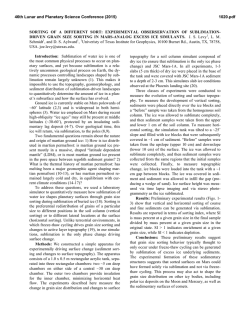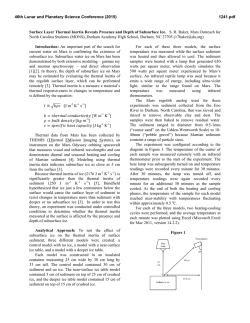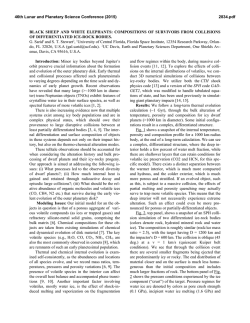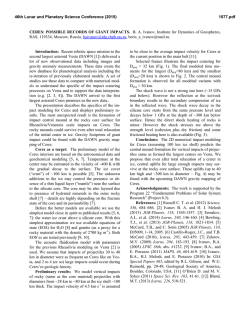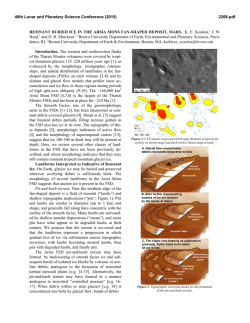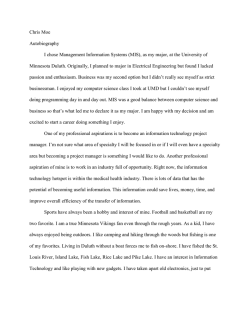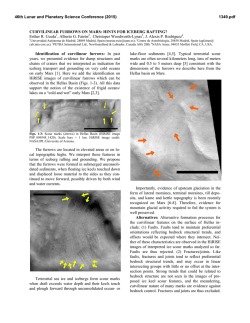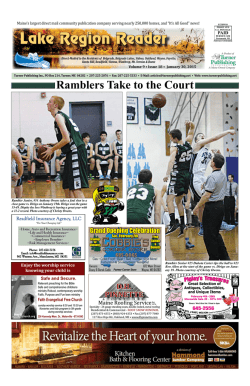
Establishing Criteria for Identifying Ancient Perennially Ice Covered
46th Lunar and Planetary Science Conference (2015) 1686.pdf ESTABLISHING CRITERIA FOR IDENTIFYING ANCIENT PERENNIALLY ICE COVERED LAKES ON EARTH AND MARS FROM SEDIMENTARY ROCKS. F. Rivera-Hernández1, T. J. Mackey1, D. Y. Sumner1, 1Earth and Planetary Sciences, University of California – Davis, Davis, CA, 95616; [email protected] Introduction: Geomorphic features on the martian surface suggest that perennially ice covered lakes (PICLs) might have been present in the martian past and possibly still today [e.g., 1-4]. Previous studies of sedimentation in PICLs on Earth have established several characteristic sedimentary processes and deposits that are different from other lakes in glacial and periglacial environments [e.g., 5-8]. However, criteria have not been established to recognize sedimentary deposits that accummulated in PICLs and to differentiate them from sediments deposited in ice-free or transiently icecovered lakes on Earth and Mars. Being able to identify if an ancient lacustrine environment had a perenial ice cover is crucial to successfully interpreting ancient climate conditions. The perennially ice covered lakes of the McMurdo Dry Valleys, Antarctica: Modern PICLs are a natural starting point for understanding sedimentation under a perennial ice cover. The diversity of PICLs in the McMurdo Dry Valleys provides an excellent natural laboratory for constraining how ice cover parameters (e.g., ice thickness and surface roughness) affect sedimentation. While previous studies of sedimentation in modern PICLs provide important insights into processes [e.g., 5-8], the different components of the lacustrine sedimentary systems have not been characterized as a whole. For example, no studies have integrated ice surface geometry, ice thickness, sediment transport processes, sediment supply, lake bathymetry, etc. into a facies model. Much is still unknown about how the different components are coupled in the sedimentation process and how these vary from lake to lake. As a first step toward developing a sedimentary facies model for PICLs, we have compiled observations from previous studies of sedimentary deposits and processes in modern PICLs on Earth to characterize how these vary between lakes with different ice cover properties (e.g., thickness and roughness). Here, we present an overview of the observations made by previous studies and our own. Overview of sedimentary processes in PICLs: The ice cover. PICLs on Earth occur in polar settings. In the McMurdo Dry Valleys, PICLs formed in areas where summer temperatures are above freezing part of the year, and meltwater accumulates in depressions or glacier-dammed valleys [e.g., 5, 6]. Ice is lost from the PICL surface by ablation, and is added to the base of the ice cover by freezing of the lake water [e.g., 9]. Lake water depths can be up to 120 m, and the lakes can have fresh to super saline water. Ice Figure 1. Aerial image of Lake Joyce cover thickin the McMurdo Dry Valleys, Antarctiness of a ca. Image shows a dark band around can the ice cover of the lake where most of PICL range from the aeolian sediment is ‘trapped’. Sedto iment banding is unique to PICLs with meters 2 decameters rough ice covers. Lake Joyce is ~1 km in scale and in area. can vary laterally within a single lake [e.g., 5-8]. The ice cover has a strong effect on various lake processes such as preventing the development of wind generated currents, restricting exchange of gases between the water and the atmosphere and changing deposition of sediment in the lake. The main source of sediment in most PICLs is the downward transport of sediment through the ice cover [e.g., 5-8]. The ice provides a surface for the lateral movement (e.g., saltation and rolling) of larger sediment particles into the middle of the lake, where roughness and cracks serve as sediment traps [e.g., 58]. The trapped sediment absorbs solar radiation, melts surrounding ice and ultimately migrates into the ice via cracks or gas bubble channels [10]. How far into the ice the sediment migrates depends on the size and composition of the particles. The sediment that is released into the lake also depends on the thickness of the ice. The ice cover is thus a natural sieve, controlling the particle size distribution (PSD) of sediment released into the water [11], and sediments on the lake bottom reflect these processes occurring in the ice cover [e.g., 5-8]. Another component of the ice that controls sediment transport within PICLs is the roughness of the ice cover. Ice covers can either be quite smooth or become very rough, with ridges of porous ice up to 1 m high and 10s of meters wide, with melt pools forming between the ridges [e.g., 5-8]. If the surface temperature is high enough, as during the summer, pools of meltwater can form and refreeze to form areas of smooth ice between the ridges. The roughness of the ice con- 46th Lunar and Planetary Science Conference (2015) trols the lateral transport of sediment over the ice and consequently the distribution and amount of sediment on the ice cover (Figure 1). In turn, sediment trapped in the ice increases melting and can increase ice cover roughness, providing a feedback process. The amount of sediment transported vertically through the ice and into the lake depends on both ice roughness and the initial distribution of sediment on the ice. Sedimentary deposits. Sedimentation in PICLs has been previously studied primarily by the use of sediment cores and sediment traps in localized regions within a lake [e.g., 5-8]. From these studies, it is known that PICLs with different ice cover thicknesses are associated with different sedimentary processes and unique sedimentary structures [e.g., 5-8]. PICLs with thick ice covers (~ > 3 m) have highly localized sedimentation, producing ridges and sand mounds [Figures 2 and 3; e.g., 5-8]. Our observations suggest that PICLs with thin ice covers (< 1 m) do not appear to show these characteristic sedimentary deposits, and instead have more laterally homogenous deposits across the lake bottom. Sealed PICLs, lakes where the ice cover extends to the lake bottom, represent another end-member case. For example, Lake Vida, Antarctica, has an ice cover that is thought to extend ~ 27 m [e.g., 12]. In this case, small pockets of sediments and thin sediment layers up to 20 cm thick are found within the ice cover, and a liquid-brine exists at the ice bottom [12]. The ice is interpreted to have formed from surface runoff, and the sediment layers represent the accumulation of fluvial and aeolian deposits on top of ice [e.g., 12]. What gets preserved from this setting in the sedimentary record has yet to be constrained. Implications for Mars: Under present environmental conditions, liquid water is not stable at the surface of Mars. However, abundant evidence for liquid water early in Mars’ history has been accumulated from rover, orbiter, and landed missions [e.g., 1-4,1315]. During this interval, there were likely small lakes similar to the modern PICLs on Earth, for example, Yellowknife Bay at the toe of the relatively young Peace Vallis fan could have been ice covered [15]. We will not know until we have the sedimentary criteria to identify PICL deposits. Concluding remarks: In summary, we present an overview of sedimentary deposits and processes in modern PICLs on Earth and highlight three-end member cases of sedimentation regimes. These end members are a starting point for investigating the factors that control sedimentation in PICLs and how these vary from lake to lake. This is crucial information that is necessary to develop a generalized sedimentary facies model for PICLs on Earth and other planetary bodies. In the martian past, there were likely small lakes similar to the modern PICLs on Earth, however until 1686.pdf we have criteria for identifying PICL deposits in the sedimentary record, we will not be able to distinguish between open water and ice-covered lakes. Figure 2. Sand mound at the bottom of Lake Hoare. The sand mound is covered by a microbial mat. Variations in the size and shape of sand mounds are thought be due to lake water depth [5]. The distance between the two red points is 10 cm. Figure 3. Sand ridge at the bottom of Lake Hoare. Sand ridges have been observed to parallel cracks in the ice cover [5, 7]. The distance between the two red points is 10 cm. References: [1] Grin, E. (1997) Icarus, 130, 461-474. [2] Howard, A. D., and Moore, J. M. (2004) GRL, 31, 1. [3] Moore, J. M., and Wilhelms, D. E. (2001) Icarus 154, 2, 258276. [4] Fairén, A. G., et al. (2014) Planetary and Space Science, 93, 101-118. [5] Squyres, S. W., Andersen, D. W., Nedell, S. S. & Wharton Jr., R. A. (1991) Sedimentology, 38, 363–379. [6] Schackman, M. A. (1994) M.S. Thesis, San Jose State. [7] Andersen, D. W., Wharton, R. A., & Squyres, S. W. (1993) AGU, pp. 71-81. [8] Doran, P. T., Wharton Jr, R. A., and W. Lyons, B (1994). J. of Paleolimnology, 10, 2, 85-114. [9] McKay, C. P., Clow, G. D., Wharton, R. A., & Squyres, S. W. (1985) Nature, 561-562. [10] Jepsen, S. M., Adams, E. E., & Priscu, J. C. (2010) Arctic, Antarctic, and Alpine Research, 42, 1, 57-66. [11] Hendy, C. H. (2000) Geografiska Annaler: Series A, Physical Geography, 82, 2‐3, 271-274. [12] Dugan, H. A. and Doran, P. T. (2014) The Cryosphere Discussions, 8, 4, 4127-4158. [13] Carr, M. H., & Head III, J. W. (2010) Earth and Planetary Science Letters, 294(3), 185-203. [14] Carr, M. H. (2012) Philosophical Transactions of the Royal Society A: Mathematical, Physical and Engineering Sciences, 370(1966), 2193-2215. [14] Grotzinger, J. P., et al. (2014) Science, 34 3(6169), 1242777.
© Copyright 2025

